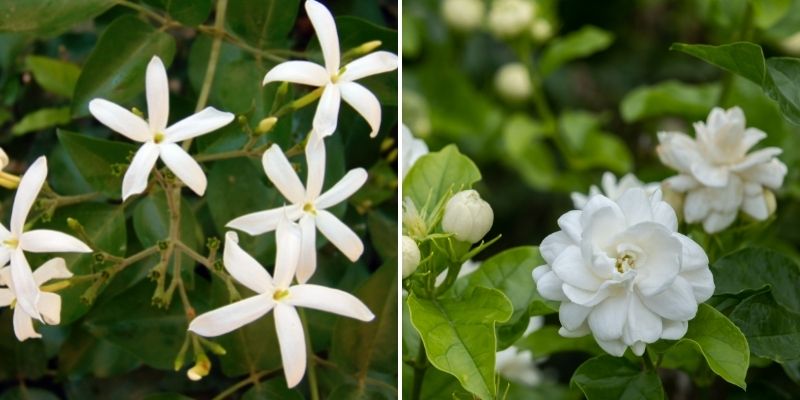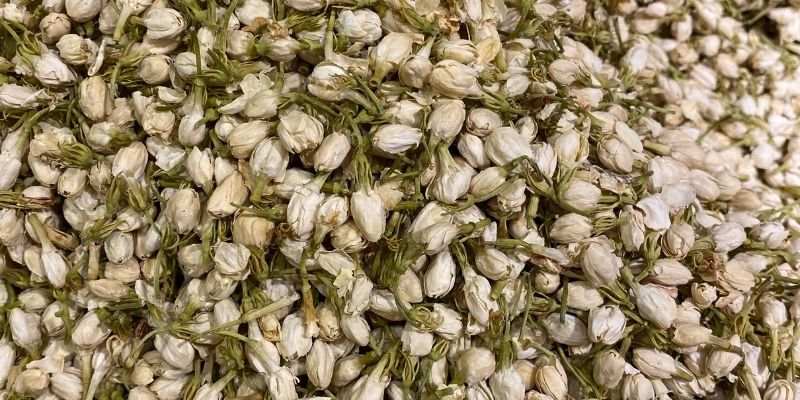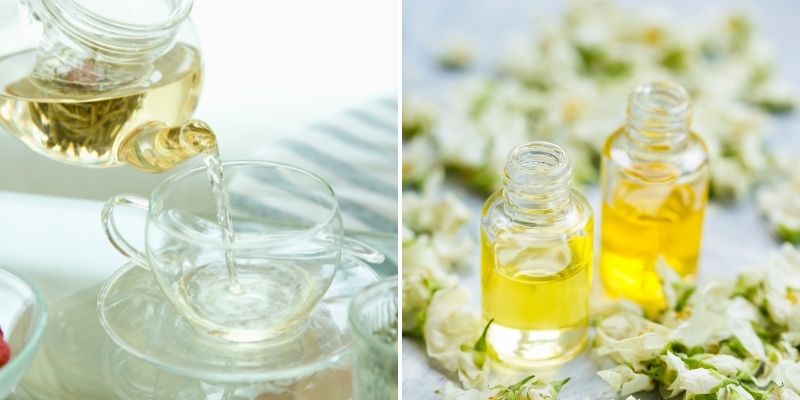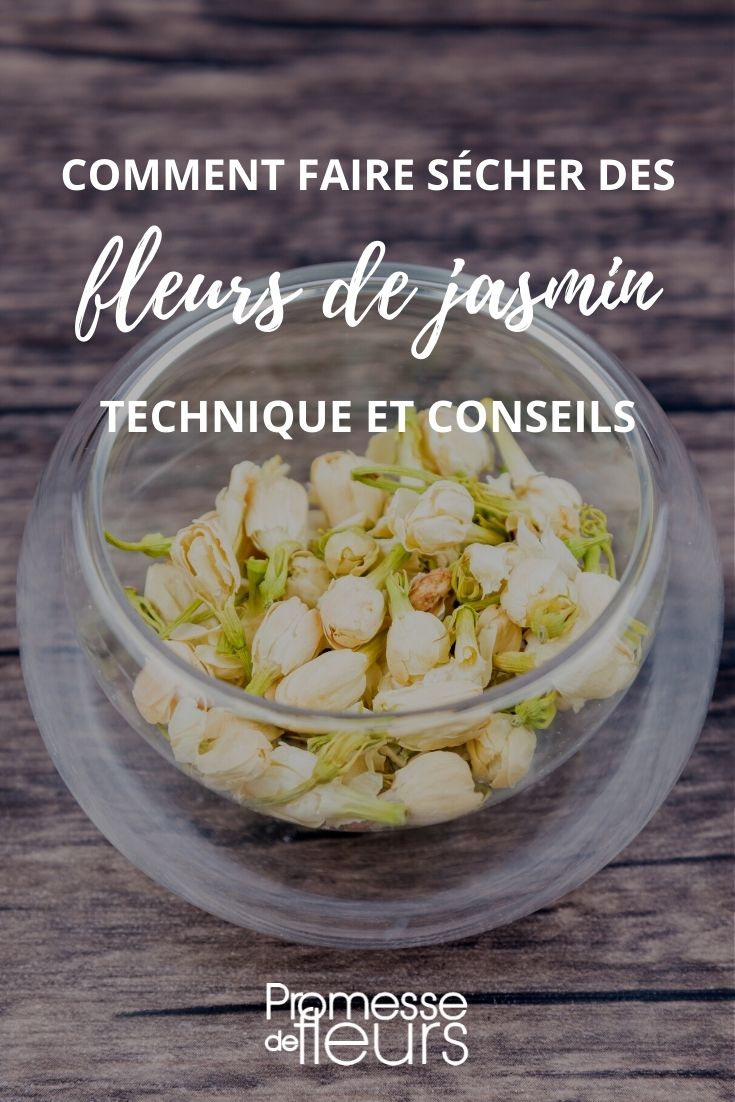Jasmine flowers emit a heady fragrance. They are, for this reason, widely used in perfumery, much like roses.
While they are very common around the Mediterranean, this climbing plant actually originates from Asia, more precisely the Himalayas. It thrives in warm climates, where its fragrance is intensified and more potent.
Depending on the jasmine species, aside from the abundant and fragrant flowering, differences exist. The foliage can be evergreen, semi-evergreen, or even deciduous in our latitudes. The growth of the liana also varies.
To use jasmine at home, the simplest method is to dry its flowers. Here are some tips to do it successfully. But first, a quick note on the jasmins commonly used.
Which jasmine to use?
In perfumery
Among the jasmins most frequently used in perfumery are Jasminum grandiflorum and Jasminum officinale, from which perfumers extract the absolute using solvents. This is a highly specific process, not reproducible at home. But you can still enjoy the intoxicating scent of jasmine by drying its flowers.
Which jasmine for tea?
For jasmine tea, another variety is typically used: the Arabian Jasmine, Jasminum sambac, whose large white flowers are added to green tea for flavouring.

Jasminum officinale and Jasminum sambac
Is jasmine toxic? Special case of Star Jasmine
The jasmins mentioned earlier, belonging to the Jasminum genus, are part of the Oleaceae family. As for Star Jasmine, while its flowers resemble the fragrance of Jasminum, it does not belong to the same family. Trachelospermum species are part of the Apocynaceae family, and many plants in this family are toxic. As a precaution, it is best not to use its flowers.
When and how to pick jasmine flowers?
When?
Jasmine flowers should be picked during their flowering period, which occurs from August to October. It is generally advised to pick the flowers before they fully bloom.
Traditionally, in Grasse, known as the Perfume Capital, the harvest of jasmine flowers begins before dawn, as early as 5 a.m. By harvesting early in the morning, you prevent the jasmine flower's fragrance from evaporating under the sun.
Choose a dry and sunny day to ensure the lowest possible humidity level.
How to harvest jasmine flowers?
The picking itself is quite easy but can be very time-consuming before obtaining even a modest quantity of flowers.
Simply pinch the base of the flowers to detach them.
How to dry jasmine flowers?
Jasmine flowers are delicate. For proper drying, ensure the flowers are not too "soft" when placed to dry. If picked when already fully bloomed, they may not dry well.
In a shaded and well-ventilated area, carefully arrange the jasmine flowers on a cloth, ensuring they do not touch each other. After a few days, they will have dried. They should retain a light colour and their full fragrance after drying. Inspect your harvest before storing.
How to store jasmine?
Jasmine flowers are quite fragile. Store them away from light, heat, and moisture.
Keeping them in a paper bag placed in a dry cupboard is a good solution. If you are certain the flowers contain no trace of moisture after drying, you can store them in an airtight container. However, if upon reopening the container you notice the flowers have darkened in colour, this is not a good sign. Do not consume them.

How to use dried jasmine flowers?
In tea or infusion
Prepare your own jasmine tea by adding a few dried jasmine flowers to your green tea leaves, adjusting to taste, to flavour your drink.
You can also make a jasmine flower infusion by pouring boiling water over the flowers and steeping for about ten minutes.
Jasmine flowers are said to have calming and relaxing properties. They may help relieve headaches and promote sleep.
In cosmetics
You can make an infusion with dried flowers for a facial treatment. Pour about 500 ml of boiling water over a handful of flowers. After 15 minutes, strain and let the infusion cool. Apply it to your face with a cotton pad or using a spray bottle.
Rich in antioxidants, this infusion may slow skin ageing. It is also believed to have purifying effects on the skin.

Jasmine flower infusion and oil maceration.
To scent laundry
Thanks to the lingering fragrance of the flowers, you can pleasantly scent your laundry by placing sachets of dried jasmine flowers in your wardrobes, between clothes and sheets, much like lavender.
In an oil macerate
You can also try making an oil macerate. This involves steeping the flowers in a vegetable oil, usually for several weeks. It is best to use dried flowers to avoid fermentation and bacterial growth.
Choose a neutral oil to allow the jasmine fragrance to fully develop. After a few weeks, once strained, you should obtain a delicately scented oil, perfect for massages.
Jasmine absolute
As mentioned earlier, extracting jasmine absolute is a highly specialised technique that seems far too complex to replicate at home. The process must be carried out very quickly, within hours of picking. Moreover, considering it takes a professional picker 2 hours to harvest 1 kg of flowers, and 8 kg are needed to produce 1 kg of absolute, it’s clear why this essence is so precious.



































Comments